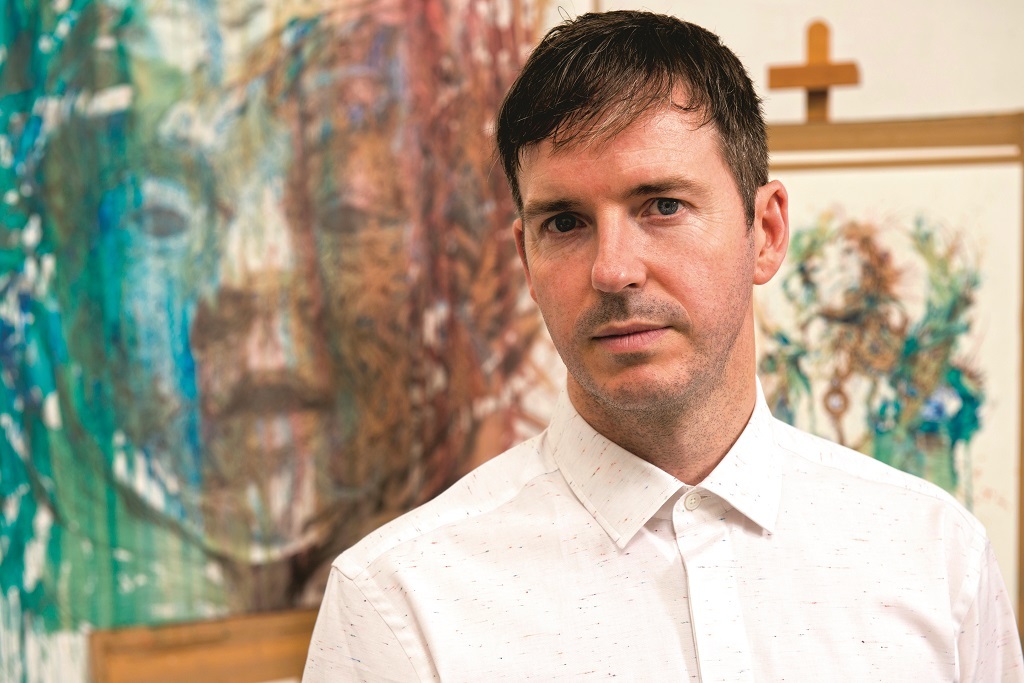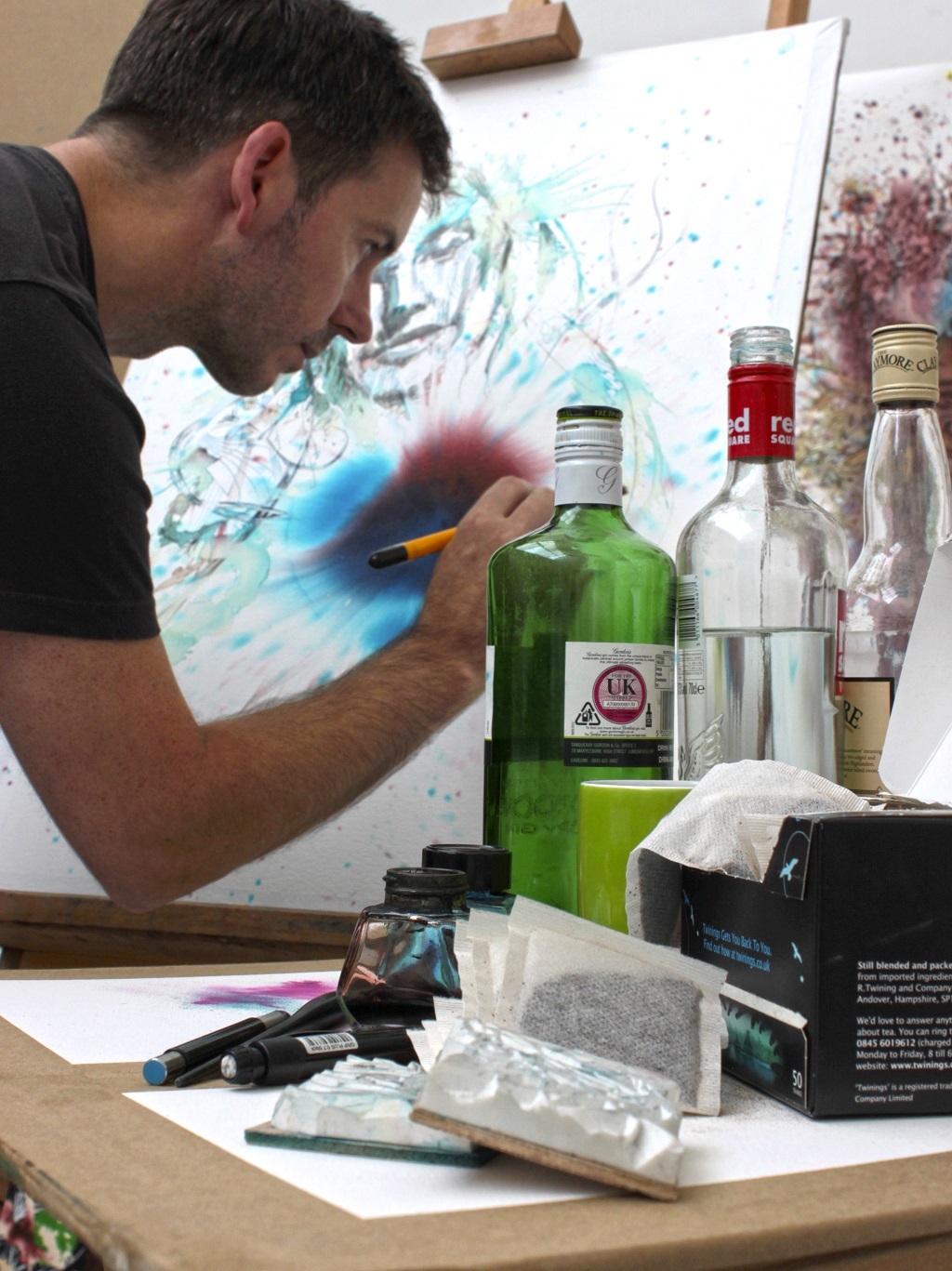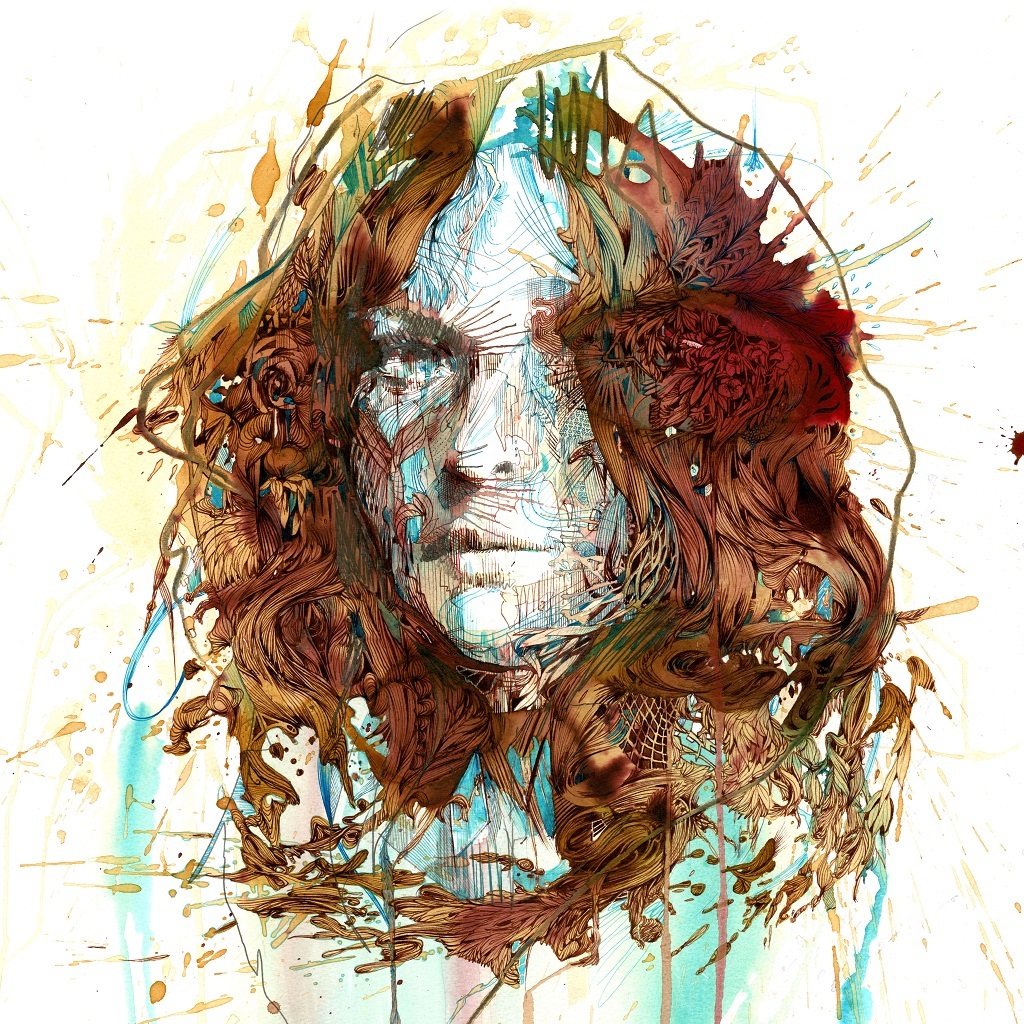
Artist Carne Griffith’s whisky art is neatly done
Fine artist Carne Griffith is taking the art world by storm with his signature style and striking images created using intricate layers of whisky and ink.
There’s many an artist who will have imbibed a dram or two to help their creative juices flow.
What is less common than an artist drinking the alcohol, however, is the sight of one sloshing it all over his work. But that’s the exact process developed by one innovative fine artist who creates his masterpieces using the amber nectar of Scotland.
Born from a love of drawing and the journey of creating an image on the page, Carne Griffths’ signature style is as striking as it is unique.
Portraiture and fantasy combine in images which explore both human and floral forms, figuratively and in an abstract sense. And whisky plays an integral part.

Artist Carne Griffiths in his studio
He explains: ‘The nice thing about working with whisky is that when you take the lid off the bottle the whole smell becomes a part of the work. It becomes a bit ritual like, so the aroma does seep into the work a little.
‘But I don’t use good whiskies, single malts – perish the thought! I’m using blends; I’ve got a bottle of Claymore on the go at the moment.’
Working with calligraphy ink, graphite and a range of liquids – with tea, brandy and vodka joining whisky in the equipment cupboard – Carne starts off with a sketch, then throws liquids over it and ‘allows things to happen’.
He continues: ‘Alcohol increases the unpredictability of where paint will dry and how it will dry. Combining the inks with the alcohol and tea makes things more random.
‘I work on stretched paper and if I have a big pool of tea on a sketch, then pour whisky into the middle of the tea, that disperses the tea. It pushes the colour away, spreads the colour aside and therefore as it’s drying the intensity of the colour is in a different place.’
His work is often an emotional response to forms and situations encountered in daily life, with everyday images recorded in a dream-like sense onto the page, where physical boundaries cease to exist. Carne’s work takes us on a journey of escapism; often focusing on scenes of awe and wonderment, they offer a sense of abandonment to the artist and to the viewer an invitation to share and explore this inner realm.

Carne Griffiths at work on another creation
Carne originally trained as a gold wire embroidery designer, a genre he worked in for 12 years.
He said: ‘When I initially graduated from college the work I produced was using similar materials to those I’m using now. I draw with Parker fountain pens, normal writing pens. I never had particularly good handwriting, but I always used to like other people’s handwriting and I liked the fountain pen. I found them quite interesting to draw with. When I left the embroidery job and started drawing again, I went back to drawing with a fountain pen straight away.’
It was around this time that Carne started experimenting with teas and alcohol. ‘Because fountain pen ink is water soluble I’d paint over the top of the drawing in clear water and I’d allow the ink to blend.
‘I’d use it to create shadows and darker areas in my work. Then I was sitting drinking a glass of brandy one night and ended up just dunking the brush in, waving it over the page and thinking, “I’ll see what happens with that.” It took off from there, experimenting with teas and realising the different effects that alcohol could have.’
Specific combinations of alcoholic liquid can also be used for special effects.
‘So when things are very nearly dry and you pour whisky over it, it has a bleaching effect on the inks,’ Carne says. But he doesn’t use it as purposefully as that. ‘I tend to just slosh it all around,’ he admits. ‘I work in quite a chaotic way. I like the accidents, they’re always the nice bits.’

The Red Flower, by Carne Griffiths
This anarchic approach seems at odds with the detailed precision in much of Carne’s work. ‘The drawings are quite detailed and that’s what comes after. So once it’s at that stage, it’s very much like a watercolour and I come back with a fountain pen and draw again over the top.
‘It’s a repeating process. So I’ll draw over the top for a while, then sometimes I’ll decide to throw more liquid over it and sometimes it will just wash away an hour’s-worth of work, but it’ll create something different. I think it’s that kind of layering process that makes the work look quite complex. There’s several layers going on and then the pen work on top of the piece gives you the detail at the end.’
Carne regularly undertakes commissions for portraits and has a number currently on the go as well as creating work for himself. ‘The portrait side has really picked up recently and I’ve also had a number of commercial commissions,’ he says. ‘I did a portrait of the American actor Jesse Eisenburg which the New York Observer used on the cover of the newspaper, and I’ve started doing more commercial projects like that.’
When he’s not undertaking commissions, Carne sells his work through various galleries around the country. At the moment, however, he’s spending a lot of time in his studio experimenting with new pieces, including working in oils.
‘It is quite a departure for me, because my work is quite spontaneous – the works in inks and alcohol happen on the page very fast. But I’ve been wanting to spend time on a body of work that’s a bit more meditative, that I can take time over, and oils by their very nature slow you down, they stop me from racing ahead,’ he says. ‘I’m trying to find a good way to balance everything in the studio – ink on paper, but at the same time canvas and oils in the background.’
For more information click HERE.
TAGS

